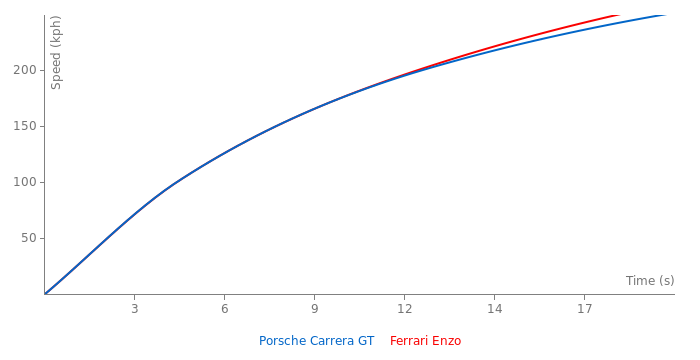The recent discussion in the “Germany vs Italy” poll section prompted me to print this post since some people write nonsense about these cars. I will try to make as detailed analysis as possible:
1- Dimensions
In general, the cars have similar size, Enzo is 9 cm longer, 11 cm wider and 2 cm lower. The wheelbase of the Enzo is 8 cm shorter due to the long front overhang, and the front and rear track is wider by about 5 and 6 cm respectively.
In the pictures from R&T below, you can clearly see that the engine and transmission of the Carrera GT are much more compact, as well as located lower due to the carbon fiber clutch disk with a reduced diameter. Enzo's engine weight is 225 kg, while the Carrera GT's is - 214. Manual gearbox of the Carrera GT weighs 65 kg, the Enzo's sequential weighs about 100 kg. Body and frame in both cases are made of carbon fiber and have a very high torsional rigidity, but the Carrera GT is still a roadster, so the Enzo is probably a little better in this respect. Dry mass of Enzo is 1365 kg, Carrera GT - 1380 kg, but the volume of the tank of Enzo is bigger (110 l against 92), so in most tests masses with the full tanks of both cars are close and vary around 1450-1480 kg. Static weight distribution in both cars is about 42/58, but the Carrera GT has a lower center of gravity and in general a greater share of mass closer to the center, which gives an advantage in mechanical grip and yaw moment.
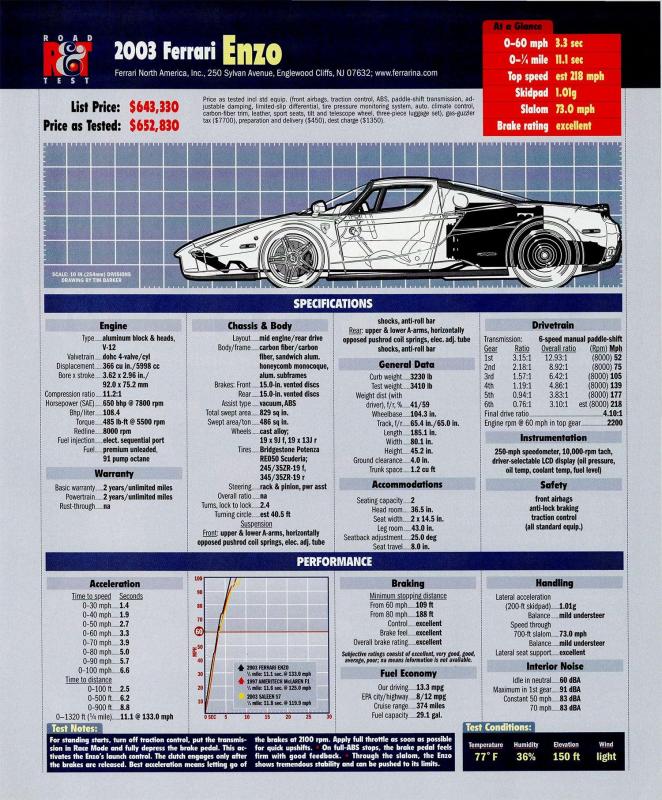
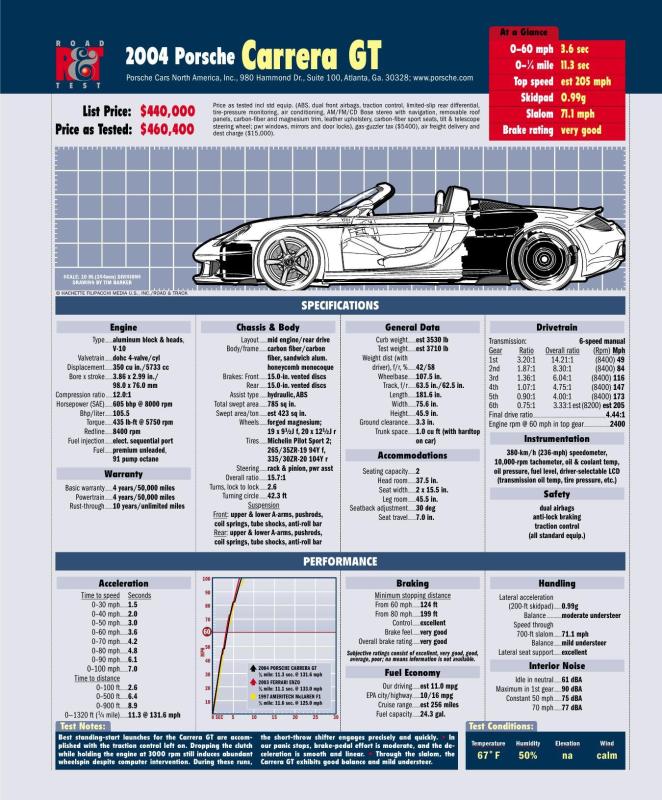
2- Engine and drivetrain
Enzo - type F140B, 65 deg V12, 5998 cc, 485 kW/ 7800 rpm, 657 Nm / 5500 rpm, redline 8200. This engine was the progenitor of a series of motors still used by Ferrari to this day. 12 Cilindri and Purosangue, for example.
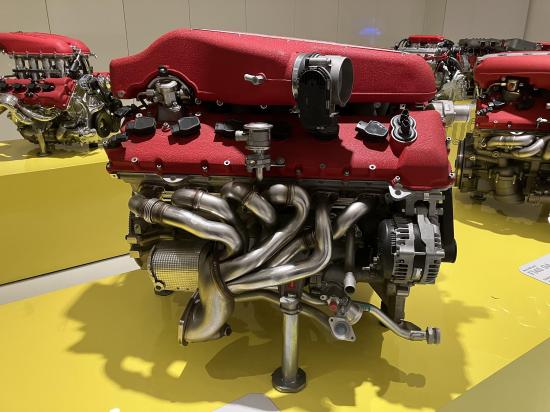
Carrera GT - typ 980/01, 68 deg V10, 5733 cc, 450 kW/ 8000 rpm, 590 Nm / 5750 rpm, redline 8400. Derived from LMP project racing engine based on 3.5L V12 from an F1 Arrows. It has a super light flywheel, so it picks up revs very quickly and drops off just as quickly.
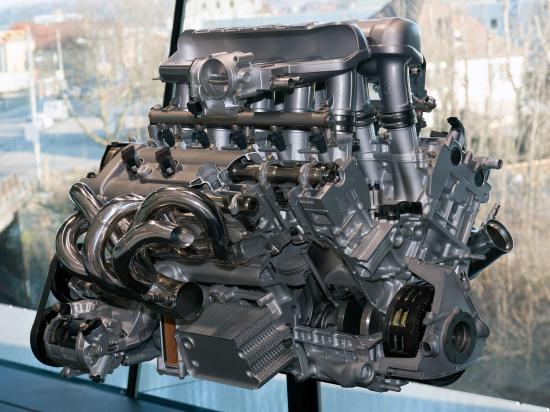
The Enzo's engine displacement is about 5% larger and due to this it has a slight torque/power advantage in the rev range, however it seems that the peak power is actually much closer than claimed. Dyno tests show that Carrera GT actually has peak power in the 620-640PS range, while for the Enzo looks like 660 is the maximum, many customer models seemed noticeably weaker.
According to Ferrari claim, Enzo's semi-automatic gearbox shifts forward in 150 milliseconds, the manual short-throw gearbox of the Carrera GT in the hands of an experienced pilot probably could perform 1-2, 3-4 and 5-6 shifts just as quickly, shifts 2-3 and 4-5 due to the zigzag hand movement will be slower. Also judging by the results of tests Enzo's launch control copes with wheelspin at the start a bit better.
Perhaps it should be clarified that the sequential gearbox was chosen by Ferrari, of course, not because they didn't have a manual gearbox capable of handling such torque. It was just that at the time, it was one of the fastest transmissions in principle. Certainly faster than any manual.
3- Aero
The drag coefficient of the Carrera GT is 0.37 (0.39 withot roof), the frontal area is 1.95m2, i.e., CDA = 0.72. The Enzo has 0.34 and 2.0m2 respectively, CDA = 0.68. Thus the Ferrari's drag is about 6% lower.
The claimed downforce values at 200kph are: 344 kg for the Enzo and 107 kg for the CGT. The Porsche's retractable wing looks slightly larger than the Ferrari's flap, but the Enzo's underbody is perhaps more advanced. Visually, however, it doesn't look like it's enough for the Enzo to have 3 times as much downforce. Sport Auto tested CGT in a wind tunnel and got 89kg at 200, which is pretty close to the claim. The Ferrari hasn't been tested, but it's been reported that it feels less pressed to the ground at speed than the Porsche. As a result, it seems to me that downforce of these cars in general is close, perhaps even slightly more in Porsche, which is confirmed by more pronounced weakening of acceleration after 250 km/h.
The downforce balance in the Carrera GT is 30% front / 70% rear, in the Enzo 40%/60%. Therefore, with increasing speed, the rear axle of the Porsche became more loaded.
4- Brakes and tires
Both cars have carbon-ceramic composite brake disks with a diameter of 380 mm all around. The wheels of the Carrera GT are made of magnesium alloy to lighten unsprung masses.
Enzo has relatively conservative Bridgestone Potenza RE050A tires more designed for comfort and daily use. The size is 245 in the front and 345 in the rear. CGT Michelin Pilot Sport 2 were much more sharpened for the track. For example, the same tires Zonda F and Maserati MC12 had as standard equipment. Size: 265 at the front (slightly wider than Enzo), 335 at the rear (slightly narrower, but on larger 20-inch wheels).
5- Straight line acceleration
Claimed figures from factory testing, 0-100/0-200/top speed:
Carrera GT - 3.7 sec / 9.9 sec / 330+ km/h
Enzo - 3.65 sec / 9.5 sec / 350+ km/h.
Some head to head comparison tests.
AMUS Nardo 0-100 / 100-200 / 200-300 / top speed:
Carrera GT 3.8 / 6.9 / 23.5 / 334 km/h
Enzo 3.7 / 6.7 / 15.8 / 355 km/h
Quattroroute 0-100 / 100-200 / 200-250 / top speed:
Carrera GT 4.0 / 7.4 / 7.3 / 333 km/h
Enzo 3.7 / 7.1 / 6.7 / 351.2 km/h
Motortrend 0-96 / 96-161 / 161-215 / top speed:
Carrera GT 3.6 / 3.7 / 3.8 / 324.3 km/h
Enzo 3.4 / 3.6 / 4.0 / 339.6 km/h.
Overall, the Enzo is obviously quicker, but only marginally in the first four gears until reaching around 230 km/h, and noticeably quicker beyond that.
6- Rivalry on tracks
As already mentioned above CGT has more rubber in the front, and generally grippier tires, lower center of gravity, all this equals - higher speed in slow and medium corners.
So on curvy technical tracks like: Autodromo del Levante Bari, Bedford Autodrome, Vairano Handling Course, the Porsche is faster. It's a bit odd that the Enzo was quicker at Dunsfold. I think there just the CGT time of 1:19.8 probably could well have been improved. We can also recall the rumor that Ferrari tested Carrera GT together with Enzo at their track Fiorano, but no results were reported. This suggests that laptimes probably was disappointing for Enzo. Fiorano is also quite a twisty track.
However the most interesting comparison is of course the Nordschleife with Mark Basseng at the wheel. And here, Enzo is just that little bit faster. But if we analyze it, it's only on the straights:
Flugplatz (corner): Carrera GT – 103.5 mph, Enzo – 100.3 mph
Schwedenkreuz (straight): Enzo – 170.5 mph, Carrera GT – 168.5 mph
Aremberg (corner): Carrera GT – 64.1 mph, Enzo – 63.9 mph
Fuchsrohre (straight): Enzo – 160.2 mph, Carrera GT – 158.9 mph
Metzgesfeld (corner): Carrera GT – 101.8 mph, Enzo – 99.7 mph
Exmuhle (corner): Carrera GT – 71.2 mph, Enzo – 68.8 mph
Bergwerk (corner): Enzo – 68.1 mph, Carrera GT – 64.5 mph
Kesselchen (straight): Enzo – 159.6 mph, Carrera GT – 150.5 mph
Hohe Acht (corner): Carrera GT – 71.3 mph, Enzo – 66.9 mph
Brunnchen (corner): Carrera GT – 68.9 mph, Enzo – 65.7 mph
Schwalbenshwanz (corner): Carrera GT – 61.5 mph, Enzo – 58.1 mph
Galgenkopf (corner): Enzo – 98.5 mph, Carrera GT – 95.0 mph
Dottinger Hohe (straight): Enzo – 189.2 mph, Carrera GT – 183.5 mph
In addition, it should be noted that Enzo's dampers failed during the Nordschleife, but it still showed a good laptime)
To summarize in general:
Short technical tracks - definitely Carrera GT.
Long high-speed circuits - rather Enzo.
And if both cars get the same tires, the chances of Ferrari Enzo would increase significantly.


